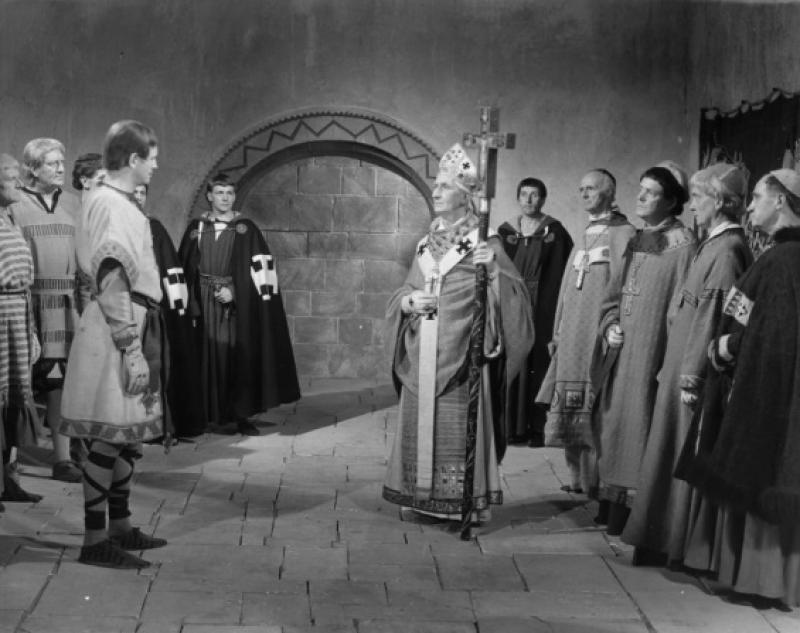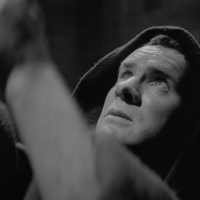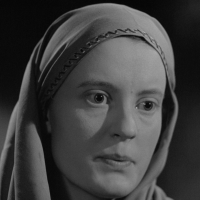DVD: Murder in the Cathedral | reviews, news & interviews
DVD: Murder in the Cathedral
DVD: Murder in the Cathedral
Reappraising George Hoellering - his screen version of TS Eliot's verse drama, and remarkable documentaries

The real achievement of this remarkable DVD release from the BFI is the fact that it brings the name of George Hoellering back to our attention as a director. His 1951 adaption of TS Eliot’s verse play Murder in the Cathedral has been virtually unavailable for years, and is the centrepiece of his career, while the accompanying documentaries here reveal a fascinating and diverse talent.
Those from the British film world of a certain vintage will certainly remember Hoellering in another role: for 36 years he was very closely involved with the much-missed Academy Cinema on Oxford Street, one of London's premier venues for screening foreign films in the UK. He worked there (as well as being a co-owner) for 36 years, right up to his death in 1980: Marking his demise Dilys Powell wrote of his achievement in that capacity that he was “as important to the screen in this country as any of the great film directors”.
Hoellering cast John Groser, a priest in real life, as Thomas Becket
Born in 1897 near Vienna into an artistic family (his father was a theatre producer) Hoellering started managing cinemas there, before moving to Berlin in the 1920s, where he worked in a number of capacities in the film industry. Foreseeing the rise of the Nazis, he left in 1932, travelling via Vienna and Hungary to England, where he arrived in 1936. The only omission in this package is his 1936 docu-fiction study of life on the Hungarian plains, Hortobagy: “It belongs to the order of Dovzhenko’s Earth without the taint of propaganda,” Graham Greene wrote at the time.
Hoellering first read Eliot’s play while interned on the Isle of Man, resolving that he would direct it. His adaptation of the stage original for the screen involved considerable changes, both the addition of new scenes (an early scene of confrontation between the Archbishop of Canterbury, Thomas Becket, and King Henry II provided explanatory context (Alexander Gauge as Henry, pictured below)) and deletions; Eliot’s own voice is included as that of the absent Fourth Tempter. The writer’s initial reluctance to have the play filmed changed dramatically after he read Hoellering’s script: “I am now convinced, as I was not before, that Murder in the Cathedral can make a fine film and a very unusual one: and I am also more certain than ever that I could not have entrusted the filming of the play to anyone but yourself.”
 The resulting adaptation of Eliot’s story of the murder of Thomas Becket is an unusual work, indeed: its interior scenes have a static, concentrated quality that keep the attention on the verse (other potentially more dramatic moments were cut), contrasted with lonely exterior landscapes that display something of a central European visual style. The use of the chorus of the women of Canterbury excels in the manner of Greek tragedy, even while the diction of some of these “scrubbers and sweepers of Canterbury” has a clipped, elevated tone reminiscent of the poet’s own voice (“the kets jumped on the bed”, “too late for ektion”, we hear).
The resulting adaptation of Eliot’s story of the murder of Thomas Becket is an unusual work, indeed: its interior scenes have a static, concentrated quality that keep the attention on the verse (other potentially more dramatic moments were cut), contrasted with lonely exterior landscapes that display something of a central European visual style. The use of the chorus of the women of Canterbury excels in the manner of Greek tragedy, even while the diction of some of these “scrubbers and sweepers of Canterbury” has a clipped, elevated tone reminiscent of the poet’s own voice (“the kets jumped on the bed”, “too late for ektion”, we hear).
Opposite a distinguished ensemble, many from the Old Vic, Hoellering cast the non-professional John Groser, a priest in real life, as Thomas, the serenity and dignity of his delivery remarkable (his physiognomy is impressive, too). His technical collaborators were his fellow central Europeans, limpid black and white cinematography from David Kosky (see Gallery below), and a busy score, frolicking underneath the words, from Hungarian Laszlo Laytha, which sounds English in exactly the same way that radio drama scores of the period do.
Before Archbishop Thomas, Hoellering had worked with the-then Archbishop of Canterbury Willam Temple on his 1944 24-minute documentary Message from Canterbury. It’s an astonishing work, produced as part of the war effort by the British Council to reinforce the values for which the country was fighting.
It’s loving and lyrical, revelling in the history of the cathedral, and the heritage of Kent itself, the fruit fields and those who work the land, those scenes cut around a sermon Temple had delivered (to a sombre, black-clad congregation) which drew parallels with previous moments of violence that Canterbury had seen, Becket’s murder clearly prime among them. Message is steeped in the British national mythology, harking right back to Chaucer’s pilgrims, in a way that brings fascinating comparison with Powell and Pressburger’s A Canterbury Tale, released in the same year.
Hoellering’s 1950 documentary, 'Shapes and Forms', must rank as among the most remarkable films on contemporary art ever made
How remarkable that this so-recently assimilated outsider, Hoellering – when disputes arose over the ending of the film the British Council wrote to Temple reminding the Archbishop that the director was “neither a British subject nor of our Faith” – could make so British a film. No coincidence that it was the same time that Eliot, the New Englander who had journeyed through European modernism, was articulating that same quintessence in his Four Quartets. Temple’s sermon is stirring stuff – not least in laying out expected post-war changes in the country’s social order – more than matching the pulpit eloquence of the-then incumbent Bishop of Chichester George Bell, that “special glory of the Church of England” who, had it not been for Churchill’s opposition, would surely have succeeded Temple at Cantab. It was Bell, in his tenure as Dean there, who had encouraged Eliot to write Murder in the Cathedral for the 1935 Canterbury festival.
Hoellering’s 1950 documentary, Shapes and Forms, also included on this release, could hardly be more different in its inspiration, and must rank as among the most remarkable films on contemporary art ever made. It followed the ICA exhibition of 1948-49 40,000 Years of Modern Art, which had set works of primitive cultures – masks, figures and objects – from all around the world with the work of a score of modernists, Henry Moore, Picasso, Matisse, Modigliani and Alexander Calder to name only a few.
The 21-minute black and white film, shot in the basement of Hoellering’s Academy Cinema, is wordless, its only verbal context given in an opening title-card that includes the phrase, “aided by the music, the camera will be your guide”. The director’s collaborators were once again Kosky and Lajtha, the latter producing a score that is a notable piece of contemporary music in itself.
This exemplary release includes an illustrated booklet with essays by the director’s son Andrew Hoellering, and his biographer Andras Szekfu, as well as his final documentary short Glasgow Orpheus Choir (1951), another affecting combination of music and landscapes. Blu-ray exclusives include the festival cut of Murder in the Cathedral, at 139 minutes (against the release cut at 114), and deleted scenes. The legacy of a remarkable figure of 20th century British (and world) cinema has been returned to its rightful prominence.
'Murder in the Cathedral' Gallery: click on first image to begin
rating
Explore topics
Share this article
Add comment
more Film
 Stephen review - a breathtakingly good first feature by a multi-media artist
Melanie Manchot's debut is strikingly intelligent and compelling
Stephen review - a breathtakingly good first feature by a multi-media artist
Melanie Manchot's debut is strikingly intelligent and compelling
 DVD/Blu-Ray: Priscilla
The disc extras smartly contextualise Sofia Coppola's eighth feature
DVD/Blu-Ray: Priscilla
The disc extras smartly contextualise Sofia Coppola's eighth feature
 Fantastic Machine review - photography's story from one camera to 45 billion
Love it or hate it, the photographic image has ensnared us all
Fantastic Machine review - photography's story from one camera to 45 billion
Love it or hate it, the photographic image has ensnared us all
 All You Need Is Death review - a future folk horror classic
Irish folkies seek a cursed ancient song in Paul Duane's impressive fiction debut
All You Need Is Death review - a future folk horror classic
Irish folkies seek a cursed ancient song in Paul Duane's impressive fiction debut
 If Only I Could Hibernate review - kids in grinding poverty in Ulaanbaatar
Mongolian director Zoljargal Purevdash's compelling debut
If Only I Could Hibernate review - kids in grinding poverty in Ulaanbaatar
Mongolian director Zoljargal Purevdash's compelling debut
 The Book of Clarence review - larky jaunt through biblical epic territory
LaKeith Stanfield is impressively watchable as the Messiah's near-neighbour
The Book of Clarence review - larky jaunt through biblical epic territory
LaKeith Stanfield is impressively watchable as the Messiah's near-neighbour
 Back to Black review - rock biopic with a loving but soft touch
Marisa Abela evokes the genius of Amy Winehouse, with a few warts minimised
Back to Black review - rock biopic with a loving but soft touch
Marisa Abela evokes the genius of Amy Winehouse, with a few warts minimised
 Civil War review - God help America
A horrifying State of the Union address from Alex Garland
Civil War review - God help America
A horrifying State of the Union address from Alex Garland
 The Teachers' Lounge - teacher-pupil relationships under the microscope
Thoughtful, painful meditation on status, crime, and power
The Teachers' Lounge - teacher-pupil relationships under the microscope
Thoughtful, painful meditation on status, crime, and power
 Blu-ray: Happy End (Šťastný konec)
Technically brilliant black comedy hasn't aged well
Blu-ray: Happy End (Šťastný konec)
Technically brilliant black comedy hasn't aged well
 Evil Does Not Exist review - Ryusuke Hamaguchi's nuanced follow-up to 'Drive My Car'
A parable about the perils of eco-tourism with a violent twist
Evil Does Not Exist review - Ryusuke Hamaguchi's nuanced follow-up to 'Drive My Car'
A parable about the perils of eco-tourism with a violent twist
 Io Capitano review - gripping odyssey from Senegal to Italy
Matteo Garrone's Oscar-nominated drama of two teenage boys pursuing their dream
Io Capitano review - gripping odyssey from Senegal to Italy
Matteo Garrone's Oscar-nominated drama of two teenage boys pursuing their dream







Comments
The article does not mention
I am delighted with this